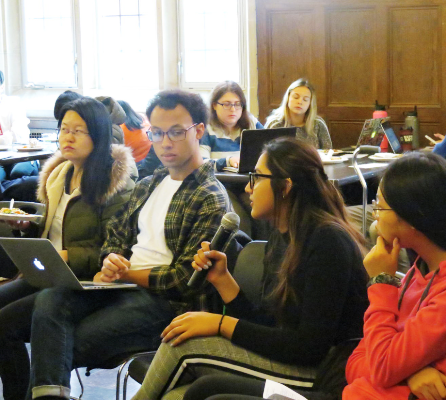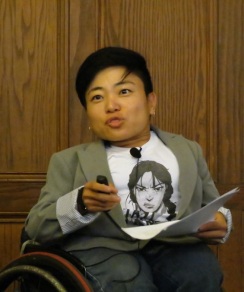Mia Ives-Rublee is an Asian American activist with a disability who is committed to justice and agency for people living with disabilities. She visited the University of Illinois at Urbana-Champaign on September 27 to speak with students about making a difference in their communities and connecting storytelling to activism. She relied on her own lived experiences as an athlete, activist, and transracial adoptee holding multiple minoritized social identities to guide the conversations.
Underpinnings for Ives-Rublee’s Engagement in Activism
Transracial adoption is a process in which a family adopts a child whose race or ethnic origin is different from their own. At the age of 3, a white middle-class family in America adopted Ives-Rublee from South Korea. As a child, her family never discussed race and ethnicity; however, disability was always part of the conversation. Ives-Rublee was always reminded by her family and doctors about what she could not do and how her disability served as a hindrance of not being able to live life to its full potential. But Ives-Rublee refused to let this be her narrative and had an opportunity to attend the Paralympics.
When Ives-Rublee attended the Paralympics for the first time, she was stunned to see so many adults living with disabilities having a great time and not dealing with others telling them what they could do versus what they could not do. This experience was transformative because she then got involved with Adaptive Sports and was able to grow while finding her voice and understanding who she was as an individual. She gained confidence and felt that it was okay for people to live with disabilities. Even through these transformative experiences, Ives-Rublee still faced multiple forms of microaggressions and stereotypes about her multiple minoritized social identities from numerous people, including her adoptive family.
Multiple Intersecting Identities
Ives-Rublee attended the University of Illinois at Urbana-Champaign. Through that experience, she explored her multiple identities as being Asian and living with a disability. However, there were times when she felt torn between the two. She hung out with her Asian friends in one space, and then hung out with her athletic friends with disabilities, who participated in track, in another. However, these two communities never integrated, and this was a struggle for her.
After Ives-Rublee graduated from Illinois with a bachelor’s degree in sociology, she attended the University of North Carolina at Chapel Hill, where she earned a master’s degree in social work. During her graduate experience, she broadened her understanding of how to discuss contemporary societal issues in a complex manner along with the intersectionality of identities. Kimberlé Crenshaw coined the term “intersectionality,” which was rooted in the research of black feminism and critical race theory.
Finding Voice and a Sense of Purpose
Ives-Rublee worked in the Division of Vocational Rehabilitation Services at North Carolina, where she helped people with mental disabilities obtain employment and connected them to community services. In this role, she learned about the various government policies poorly affecting this community. She became extremely frustrated with the system and has since become involved with several organizing efforts focusing on creating inclusive spaces and influencing policies for people living with disabilities. Ives-Rublee also founded and coordinated the Women’s March Disability Caucus and was honored as the Glamour Woman of the Year in 2017. All of these experiences, and others, further cultivated her passion and determination to continue fighting against societal wrongs and injustices around the world, especially for people living with disabilities.
Importance of Storytelling
 Ives-Rublee identified storytelling as an important skill for all activists and those who are interested in getting involved in advocacy work and community organizing. To help students better understand the meaning of storytelling and how this is done in an effective way to gain favorable outcomes, she asked them to pick an issue that they were passionate about such as women’s rights, gentrification, and adoption rights. Then students reflected on a time when that issue affected them and why it was important. In order to exercise students’ abilities to tell their stories, they shared their experiences with a peer. This activity gave them the space to think critically and engage in deep reflection with someone who may not share similar interests. The goal of this activity measured how effective they were at communicating stories to garner interest and support. Students contemplated the following questions:
Ives-Rublee identified storytelling as an important skill for all activists and those who are interested in getting involved in advocacy work and community organizing. To help students better understand the meaning of storytelling and how this is done in an effective way to gain favorable outcomes, she asked them to pick an issue that they were passionate about such as women’s rights, gentrification, and adoption rights. Then students reflected on a time when that issue affected them and why it was important. In order to exercise students’ abilities to tell their stories, they shared their experiences with a peer. This activity gave them the space to think critically and engage in deep reflection with someone who may not share similar interests. The goal of this activity measured how effective they were at communicating stories to garner interest and support. Students contemplated the following questions:
- Does my partner understand what I am trying to say?
- Are the goals of what I am trying to accomplish easily identifiable through my story?
- Is my story unclear, making it hard for others to follow along?
Ives-Rublee stated that it is very important for students to think about how they are sharing details because stories have the potential to move people. Students were encouraged to communicate their stories in a manner that is efficient, realistic, and as succinct as possible while having impact. She said they should also practice telling their stories with individuals whom they want to organize with. In this way, they have an opportunity to make mistakes, remove filler language, and focus on the most salient and key points they want listeners to remember.
Applicability to Postsecondary Educators
Storytelling can be applicable to faculty and staff when teaching diverse learners as well."
Mia Ives-Rublee presented students with helpful resources and strategies when participating in their community-organizing efforts. However, storytelling can be applicable to faculty and staff when teaching diverse learners as well. Today, postsecondary educators are embedding storytelling practices into their curricular pedagogies, offering varied methods to engage student voice and conceptualize content (Caminotti & Gray, 2012). This approach excites the imagination and sparks curiosity for learners of all ages (Caminotti & Gray, 2012).
In addition, educators are encouraged to be culturally responsive and build their curriculums around student interests. When the curricula are connected to students in such a personalized way and they can see themselves in the stories based on their own lived experiences, the chances of them achieving success and understanding the content is much greater (Anderson, 2004; Cleverley-Thompson, 2018). This is particularly true for adult learners (Caminotti & Gray, 2012).
Research has shown that storytelling is an effective technique for adult leaders along with several other approaches including case study analysis, experiential education, role playing, and small-group discussions (Caminotti & Gray, 2012; Anderson, 2004). When postsecondary educators establish culturally responsive learning and student-centered environments through storytelling, this will have lasting impressions on any learner. Students will be better prepared to achieve their personal and professional goals while enrolled in postsecondary education—and beyond—as a result.
References
Anderson, K. (2004). Speaking from the heart: Everyday storytelling and adult learning. Canadian Journal of Native Education, 28(1/2), 123.
Caminotti, E., & Gray, J. (2012). The effectiveness of storytelling on adult learning. Journal of Workplace Learning, 24(6), 430-438.
Cleverley-Thompson, S. (2018). Teaching storytelling as a leadership practice. Journal of Leadership Education, 17(1), 132-140.




Leave a comment